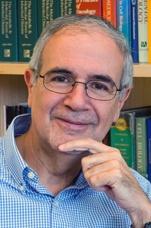
Juan S. Bonifacino, Ph.D.
NIH Distinguished Investigator
Section on Intracellular Protein Trafficking
NICHD/DIR
Research Topics
We investigate the molecular mechanisms by which transmembrane proteins (referred to as cargo) are sorted to different compartments of the endomembrane system in eukaryotic cells. The system consists of an array of membrane-enclosed organelles including the endoplasmic reticulum (ER), the Golgi apparatus, the trans-Golgi network (TGN), endosomes, lysosomes, lysosome-related organelles (LROs) (e.g., melanosomes), and different domains of the plasma membrane in polarized cells (e.g., epithelial cells and neurons). Transport of cargo between these compartments is mediated by carrier vesicles or tubules that bud from a donor compartment, translocate through the cytoplasm, and eventually fuse with an acceptor compartment. Work in our laboratory focuses on the molecular machineries that mediate these processes, including (1) sorting signals and adaptor proteins that select cargo proteins for packaging into the transport carriers, (2) microtubule motors that drive movement of the transport carriers and other organelles through the cytoplasm, and (3) tethering factors that promote fusion of the transport carriers to acceptor compartments. We study these machineries in the context of different intracellular transport pathways, including endocytosis, recycling to the plasma membrane, retrograde transport from endosomes to the TGN, biogenesis of lysosomes and LROs, and polarized sorting in epithelial cells and neurons. We apply knowledge gained from this research to the elucidation of protein trafficking diseases including neurodevelopmental disorders.
Biography
Dr. Juan Bonifacino received his doctoral degree in biochemistry from the University of Buenos Aires, Argentina, in 1981. He then moved to the NIH, where he pursued postdoctoral studies with Dr. Richard D. Klausner. He rose through the ranks to his current position as Head of the Section on Intracellular Protein Trafficking, NICHD, NIH. In 2008, he was appointed NIH Distinguished Investigator. Since the early 1990s, Dr. Bonifacino's group has conducted research on signals and adaptor proteins that mediate protein sorting to endosomes and lysosomes. His group discovered new sorting signals and adaptor proteins, and applied this knowledge to the elucidation of the causes of various human diseases including the Hermansky-Pudlak syndrome type 2 and hereditary spastic paraplegias. Dr. Bonifacino has served in various editorial capacities for the journals Developmental Cell, Molecular Cell, Molecular Biology of the Cell, Journal of Cell Biology, Journal of Biological Chemistry, Traffic and Current Protocols in Cell Biology. He served as a member of the Council of the American Society for Cell Biology, and chaired various scientific conferences. He has delivered the Alex Novikoff, Leonardo Satz, G. Burroughs Mider, Hughlings Jackson, Peter Maloney, Keith Porter, Joseph Calandra, and Andrew Somlyo lectures, and is an Honorary Professor of Biological Chemistry at the University of Buenos Aires and a recipient of the 2025 Van Deenen Medal. He was appointed Fellow of the American Society for Cell Biology. His lab has trained over 90 postdoctoral fellows and students, most of whom have pursued careers in academic research.
Selected Publications
- De Pace R, Ghosh S, Ryan VH, Sohn M, Jarnik M, Rezvan Sangsari P, Morgan NY, Dale RK, Ward ME, Bonifacino JS. Messenger RNA transport on lysosomal vesicles maintains axonal mitochondrial homeostasis and prevents axonal degeneration. Nat Neurosci. 2024;27(6):1087-1102.
- De Pace R, Maroofian R, Paimboeuf A, Zamani M, Zaki MS, Sadeghian S, Azizimalamiri R, Galehdari H, Zeighami J, Williamson CD, Fleming E, Zhou D, Gannon JL, Thiffault I, Roze E, Suri M, Zifarelli G, Bauer P, Houlden H, Severino M, Patten SA, Farrow E, Bonifacino JS. Biallelic BORCS8 variants cause an infantile-onset neurodegenerative disorder with altered lysosome dynamics. Brain. 2024;147(5):1751-1767.
- Shelke GV, Williamson CD, Jarnik M, Bonifacino JS. Inhibition of endolysosome fusion increases exosome secretion. J Cell Biol. 2023;222(6).
- Ishida M, Golding AE, Keren-Kaplan T, Li Y, Balla T, Bonifacino JS. ARMH3 is an ARL5 effector that promotes PI4KB-catalyzed PI4P synthesis at the trans-Golgi network. Nat Commun. 2024;15(1):10168.
- Ishida M, Otero MG, Freeman C, Sánchez-Lara PA, Guardia CM, Pierson TM, Bonifacino JS. A neurodevelopmental disorder associated with an activating de novo missense variant in ARF1. Hum Mol Genet. 2023;32(7):1162-1174.
Related Scientific Focus Areas
This page was last updated on Monday, December 1, 2025



